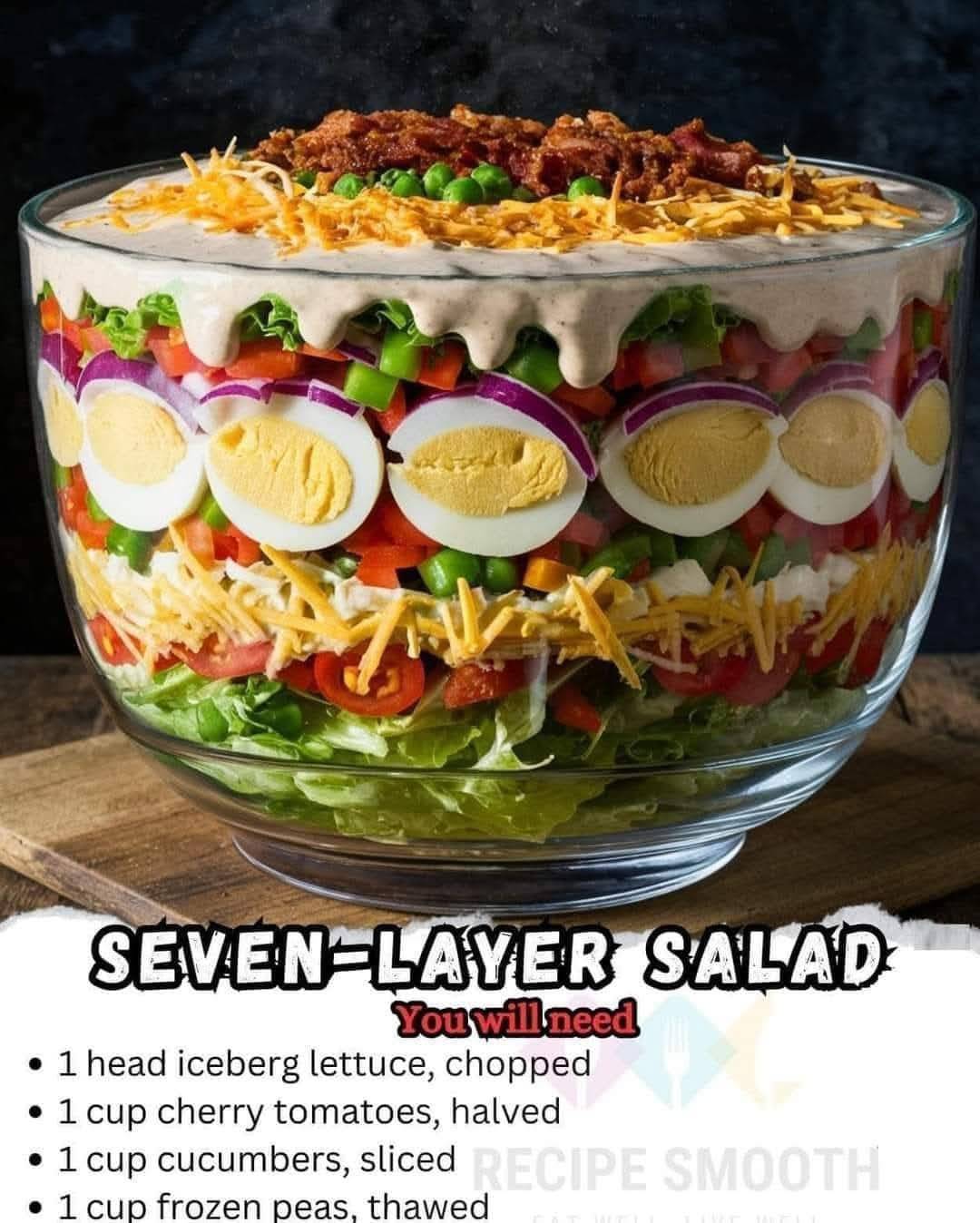ADVERTISEMENT
# Seven-Layer Salad: A Classic Dish with Endless Appeal
Seven-Layer Salad is a quintessential American dish, known for its vibrant colors, rich layers of flavor, and refreshing crunch. Served cold and often found at picnics, potlucks, and holiday gatherings, this layered salad is both visually striking and a crowd-pleaser. It’s the kind of dish that people can’t resist reaching for, offering a perfect combination of textures and tastes. But while it’s visually impressive and delicious, Seven-Layer Salad is also highly versatile and simple to prepare.
This dish consists of several layers of ingredients, including fresh vegetables, a creamy dressing, and sometimes cheese or bacon, all arranged in a glass dish to showcase the colorful, eye-catching layers. It’s more than just a salad; it’s a show-stopper at any occasion.
In this comprehensive article, we will dive deep into the origins of the Seven-Layer Salad, explore its ingredients, provide you with a step-by-step guide for making it, share variations for customization, and offer expert tips on making this dish your own. By the end of this article, you’ll have all the information needed to create the perfect Seven-Layer Salad that will be loved by all.
—
### **Table of Contents**
1. **Introduction: Why Seven-Layer Salad is a Timeless Favorite**
2. **The History of Seven-Layer Salad**
3. **The Classic Ingredients for Seven-Layer Salad**
4. **How to Make Seven-Layer Salad: Step-by-Step**
5. **Tips for the Perfect Seven-Layer Salad**
6. **Customizing Your Seven-Layer Salad: Endless Variations**
7. **Healthier Alternatives and Modifications**
8. **Seven-Layer Salad for Different Occasions**
9. **How to Store and Serve Seven-Layer Salad**
10. **Conclusion: A Dish That Brings People Together**
—
### **1. Introduction: Why Seven-Layer Salad is a Timeless Favorite**
There’s something undeniably satisfying about a well-constructed Seven-Layer Salad. The bright, colorful layers of vegetables stand in perfect contrast to the creamy, tangy dressing that holds it all together. It’s a dish that’s easy to prepare, endlessly customizable, and can be made ahead of time—making it an ideal choice for busy gatherings or family dinners.
Seven-Layer Salad brings a balance of fresh, raw vegetables with a creamy dressing, offering a mix of flavors that everyone can enjoy. It’s the kind of salad that can stand on its own or complement a variety of other dishes. Its versatility and simplicity make it a must-have for gatherings of all kinds, and its ability to look impressive with little effort makes it perfect for showcasing your culinary skills (even if you’re not a professional chef).
—
### **2. The History of Seven-Layer Salad**
Like many classic recipes, the origins of Seven-Layer Salad are a bit murky. However, the dish is thought to have gained popularity in the 1950s and 1960s in the United States. The layered salad fits right into the trends of the mid-20th century, where casseroles and layered dishes were all the rage. With its vibrant colors and ease of preparation, Seven-Layer Salad became a go-to choice for family gatherings, church picnics, and holiday feasts.
Although it was popularized in the United States, Seven-Layer Salad has inspired similar dishes in many countries. It is an example of how a simple idea—layering ingredients—can result in a dish that feels extravagant and exciting.
Though recipes vary, the essential concept of the Seven-Layer Salad remains the same: fresh, crisp vegetables, a creamy dressing, and often, a garnish of bacon or cheese. The dish may have originated in the U.S., but it has been adapted and embraced around the world, evolving to suit different tastes and dietary preferences.
—
### **3. The Classic Ingredients for Seven-Layer Salad**
The beauty of Seven-Layer Salad lies in its layers, each contributing to the flavor and texture of the final dish. Let’s break down the classic ingredients typically used in a Seven-Layer Salad:
#### **1. Lettuce**
The base of the salad, lettuce adds a refreshing crunch and acts as a foundation for the rest of the layers. Romaine lettuce is a popular choice because of its crisp texture and slightly bitter flavor, but iceberg lettuce or any other type of leafy green can be used.
#### **2. Tomatoes**
Diced tomatoes provide juicy, slightly tangy notes that balance the creaminess of the dressing. Cherry or grape tomatoes are often preferred for their sweetness and bite-sized convenience.
#### **3. Cucumbers**
Cucumbers are a cool and crunchy addition to the salad. Their mild, refreshing flavor contrasts nicely with the other vegetables. Be sure to peel and slice them thinly for the best texture.
#### **4. Red Onions**
Thinly sliced red onions add sharpness and a bit of heat. If you find raw onions too strong, you can soak them in water for a few minutes to mellow out their flavor.
#### **5. Peas**
Frozen peas are a traditional addition to Seven-Layer Salad. They add a slight sweetness and a pop of color, making them an essential layer in this dish. There’s no need to thaw the peas before adding them to the salad.
#### **6. Hard-Boiled Eggs**
Hard-boiled eggs are a rich, protein-packed layer in the salad, offering a creamy texture that complements the dressing and other vegetables. They can be chopped or sliced before being added.
#### **7. Bacon** (Optional but recommended)
Crispy, crumbled bacon adds a savory crunch and smoky flavor that elevates the dish. For a vegetarian version, consider substituting with toasted nuts like pecans or sunflower seeds.
#### **8. Dressing**
The dressing is crucial to the success of this salad. Typically, a mayonnaise-based dressing is used, often mixed with sour cream, vinegar, and seasonings. The dressing binds the ingredients together and adds richness and flavor. Some variations include a bit of sugar or mustard for added sweetness and tang.
For Complete Cooking STEPS Please Head On Over To Next Page Or Open button (>) and don’t forget to SHARE with your Facebook friends
